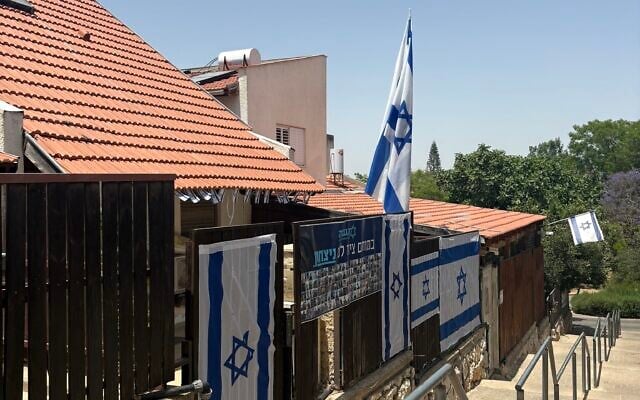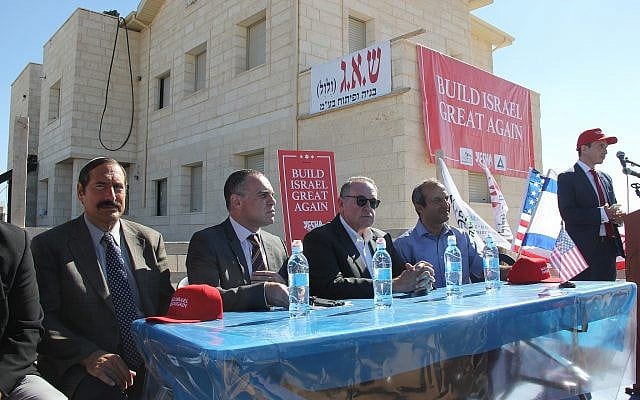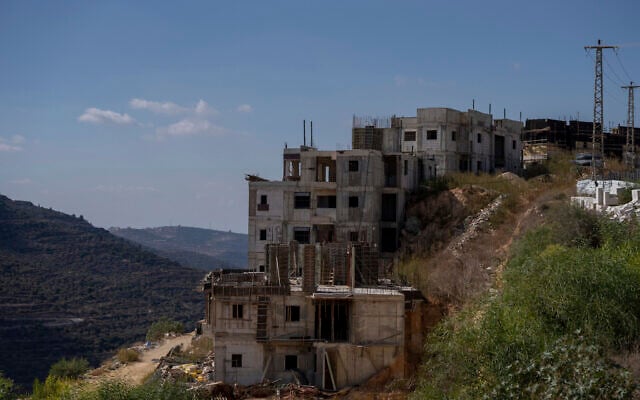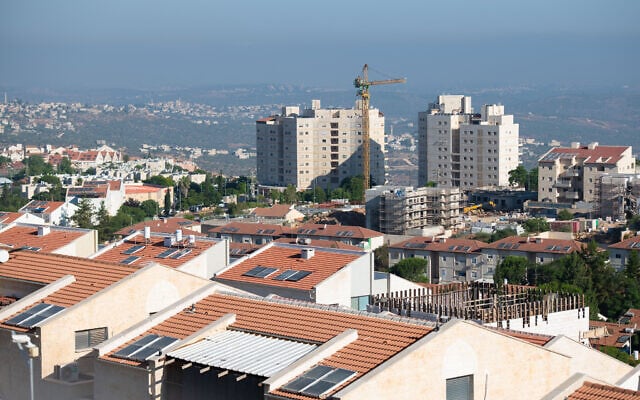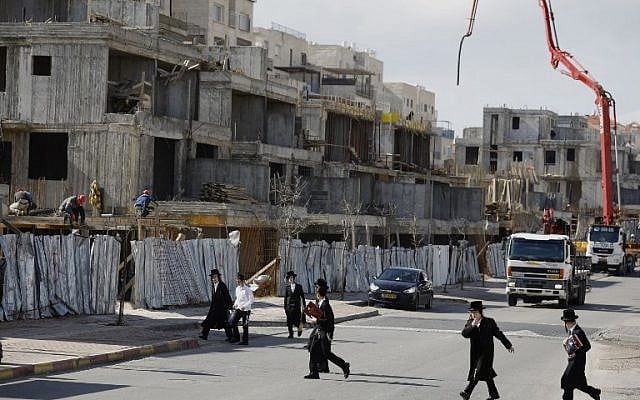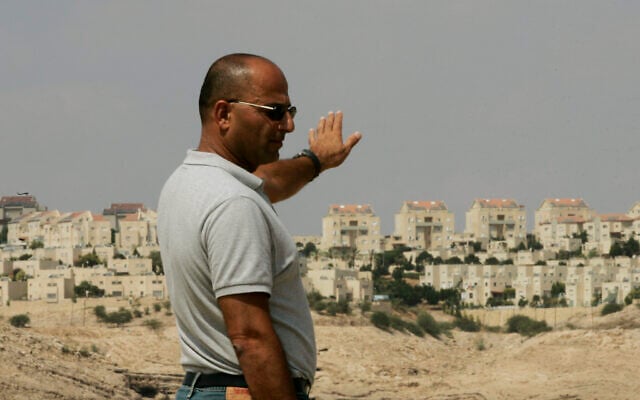


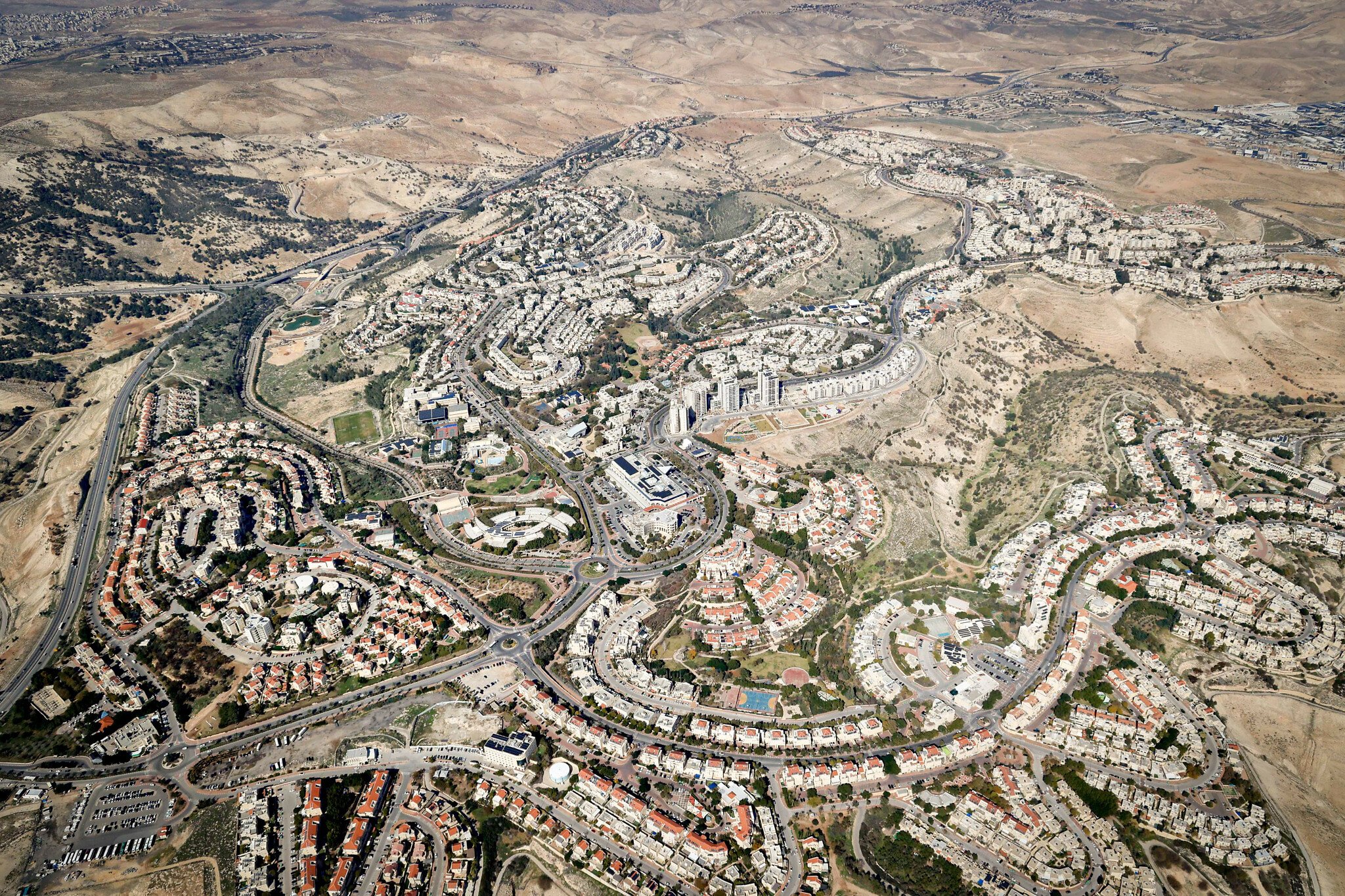
When Tova Dvorin moved to the West Bank settlement of Ariel from Jerusalem in 2013, she didn’t anticipate that she’d be living there 12 years later.
“We originally came for my husband’s physical therapy studies at the university. I thought it would be temporary,” said Dovrin, a 35-year-old mother of three, as she sipped her iced coffee at a quiet cafe in Ariel on an unseasonably warm May day.
Dovrin, a senior production marketing manager at a cyber company in Tel Aviv, and her husband quickly felt at home in the diverse community and decided to settle there, attracted to the quality of life, mix between urban and small-town feel, and affordable cost of living.
In 2021, the couple bought a four-and-a-half-bedroom condo for NIS 1.37 million ($386,400) — something that Dovrin said they never could have afforded elsewhere in the country.
Ariel is also one of the largest Israeli settlements in the West Bank, home to 21,841 residents, according to Israel’s Central Bureau of Statistics, and located over 15 kilometers (nine miles) beyond the Green Line.
“Normal people live here,” she said, laughing. “There’s affordable housing, and it’s a nice community.”
The small city’s demographic makeup — it has more secular residents than religious ones — is rare among settlements, and can be credited at least in part to the large wave of immigrants from the former Soviet Union who arrived in the 1990s and early 2000s.
While more religious families have moved to Ariel in recent years, Dvorin said their motivations tend to be practical, like her own — cheaper housing, better quality of life — rather than ideological.
And generally speaking, as affordable as Ariel is compared to Israel proper, it’s far from the cheapest settlement.
Dovrin said that she and her husband considered buying in nearby settlements such as Nofei Nehemia, an outpost of roughly 12 families that’s considered illegal under Israeli law.
“We could have bought a mansion for the same price as our condo in Ariel,” Dovrin said, but the couple ultimately felt that it was too isolated and intense for them.
Her husband now works across the street, their youngest daughter’s kindergarten is visible from their window and her elder daughter’s school is a seven-minute walk.
“This is home,” she said. “The location is perfect.”
The streets of Ariel are pristine — lined with trees, manicured lawns and neat rows of low-rise apartment buildings and detached homes. With its playgrounds, cafes and pizza shops, university, performing arts center and more, Ariel looks and feels like a safe, suburban city.
Built in 1978 to establish a permanent Israeli presence deep inside the West Bank and effectively bisect the northern part of the territory, Ariel was established by design as a literal and political fork in the road for a future contiguous Palestinian state.
The city’s growth reflects a broader strategy in which the state incentivizes population growth in the settlements through a vast web of financial incentives and government support.
This strategy has become increasingly relevant amid soaring housing prices and the rising cost of living in Israel.
For many young families and middle-class Israelis, buying a home within Israel’s recognized borders has become increasingly out of reach, with average apartment prices far exceeding NIS 2 million ($562,000), according to the Central Bureau of Statistics.
In contrast, homes in West Bank settlements remain significantly more affordable, with spacious apartments and even private houses often available for hundreds of thousands of shekels less. This stark price gap has made settlements an attractive option for Israelis priced out of the market elsewhere.
This affordability isn’t just a statistic — it’s a key factor shaping where many Israelis choose to live.
Akiva (who asked that his last name not be used) and his wife moved to Efrat, a settlement south of Jerusalem, in 2018 after getting married. There, they were able to rent an apartment for just NIS 2,500 ($700) — dramatically cheaper than the NIS 4,000 ($1,125) friends were paying in Jerusalem for smaller and shabbier spaces.
The couple left Efrat to live abroad for two years, not intending to return to the city, but found upon their return that even after a significant rise in prices (their rent had doubled), it was still a better bang for their buck than almost anywhere else.
Now looking to buy, Akiva said that they will likely remain in Efrat but are considering less central settlements, including Kfar Eldad and Nokdim, where homes are still within financial reach.
“They’re more east of the [Etzion Bloc], less mainstream, but at least you can actually buy something,” he said.
Uri Venkert, a real estate agent based in the settlement of Na’ale outside of Modi’in, agreed that affordability and quality of life are key factors driving Israelis to the area.
“It’s still relatively less expensive to buy here than elsewhere,” he said, noting that a four-room apartment in Modi’in costs about the same as a 160-square-meter duplex with a garden and yard in Na’ale.
Home to roughly 850 families, Na’ale includes a mix of religious and secular residents, with a notable number of French and Russian-speaking immigrants.
Venkert said demand surged after the COVID-19 pandemic, when he sold around 11 homes in Na’ale and the nearby settlement of Nili over six months in 2023.
“People realized how hard it was to live in a four-person apartment with nowhere to go,” he said. “The quality of life is very high here. It feels like a kibbutz or a moshav.”
Concurrent to the rise in demand, prices in settlements like Na’ale, Nili, and Beit Aryeh rose significantly in 2023 — like the rest of the market — but since the war started, demand has waned, Venkert said.
He expects there to be a new wave of demand once the long-anticipated highway, Route 446, is expanded. Currently, a narrow, two-lane road connecting the Shilat junction near Modi’in to the Baruchin Interchange on Highway 5 in the north, Route 446 is being widened to four lanes, with an additional lane for public transportation — just one example of the investment in infrastructure the government has undertaken in the West Bank.
The highway is the main access route from Modi’in Ilit — one of the largest settlements — to the country’s center.
According to Venkert, the upgraded highway is expected to become operational within the next year. “Once it opens, the dynamic will change. It’s designed for 100,000 people to use daily,” he said.
According to Israeli human rights group B’Tselem, much of this population growth is in part because the government has financially incentivized Jewish Israelis to move to West Bank settlements and develop businesses within them.
“The entire Israeli project — every branch of government — is involved in this in some way,” said Shai Parnes, a spokesperson for B’Tselem.
One of the main mechanisms used to channel government resources to settlements is by designating most of them as a National Priority Area (NPAs). These communities — primarily in Judea and Samaria, the Negev and the Galilee — receive a range of benefits, mainly in housing, education and welfare. The explicit goal of NPA designation is to aid their advancement and encourage residents and new immigrants to settle in these areas.
Among the most important benefits are discounted land leasing fees, which lower housing costs substantially. Israel Land Authority Board decisions in 2016 (No. 1490) and 2017 (No. 1505) provided discounts of 21-41% on residential land leases in NPAs, capped at NIS 450,000 ($126,000), and 31-51% for industrial land leases.
In 2023 and 2024, government policies expanded these benefits significantly. The prime minister announced last year that the Israel Land Authority would increase discounts from NIS 450,000 to NIS 850,000 for first-time homebuyers in NPAs, with an additional 10% discount available for active IDF reservists.
In some cases, repayment rates for land leasing fees were further reduced from 31 percent to 26% in “A” priority areas, and from 51% to 26% in “B” priority areas, with total subsidies reaching as high as NIS 900,000.
While the announcement emphasized the Negev and Galilee — particularly in light of Israel’s ongoing war — these benefits apply to all NPAs, including many localities in the West Bank.
Municipalities in the West Bank receive funding and subsidies funnelled through the Interior Ministry to local and regional councils, according to Dr. Shaul Arieli, a former IDF colonel, a leading expert on the Israeli-Palestinian conflict, and an advisor to the Israel Policy Forum.
“As of 2022 [the most recent data available on the subject] settlements received between 50% and 60% more in government subsidies than other Israeli municipalities,” Arieli said.
According to research by Arieli, the Israeli government allocated around NIS 30 billion ($8.4 billion) to West Bank municipalities between 2005 and 2022.
While Arieli emphasized that Israel’s financial policy toward West Bank settlements is nothing new, it has intensified under the current government, and in particular since Bezalel Smotrich — a longtime champion of the settlement movement who has made expanding and formalizing Israeli control over the West Bank a key part of his agenda — became Finance Minister.
“[Smotrich] took 13 neighborhoods within existing settlements and reclassified them as 13 new ones,” Arieli said. “That way, he can funnel even more money to them.” (Some of these “neighborhoods” were kilometers from their anchor settlements. For example, Alon, once labeled a neighborhood of Kfar Adumim, is 3.2 kilometers or 2 miles away.)
Smotrich described the move in March as an important step on the path to “de facto [Israeli] sovereignty” over the West Bank.
As of 2023, the Israeli settler population in the West Bank reached 517,407. A significant portion of this population — close to 40%, according to Arieli — is Haredi, a community with the highest birth rate in Israel, low workforce participation and greater reliance on welfare and National Insurance payments.
The two largest and fastest-growing settlements, Modi’in Illit and Beitar Illit, are both Haredi and together account for approximately 145,000 residents — about 28% of all West Bank settlers.
According to Arieli, 42% of the settler population lives below the poverty line — double the national average of 20% — a trend he said is driven largely by the socioeconomic profile of the settler population.
Immigration has slowed in recent years, he claimed, and more Israelis are moving abroad than new immigrants coming to Israel. However, the settlement population continues to rise.
“The numbers go up every year,” Arieli said. “Smotrich is trying to entrench it even further.” (Neither the Prime Minister’s Office nor Finance Minister Bezalel Smotrich’s office responded to a request for comment.)
While the full data from 2023 has not yet been published, Arieli expects little change.
“We’re still working with 2022 numbers,” he said. “But the trend is clear. This policy hasn’t just continued — it’s become more aggressive under recent governments, including Bennett’s, and certainly under the current one.”
The goal, Arieli said, is clear: to entrench demographic and infrastructural facts on the ground in the West Bank in ways that military force alone cannot accomplish, and thereby decrease the possibility of a two-state solution with the Palestinians.
“If the settlement population grows large enough, it becomes politically impossible to talk about evacuating them,” he warned.


